Lines
In mathematics, a line is a straight one-dimensional figure that extends infinitely in both directions. It is often represented by a straight line with arrows at each end to indicate its infinite nature. Lines are fundamental to geometry and have several important properties and characteristics.
Types of Lines
There are different types of lines, including:
- Straight Line: A line that does not bend or curve.
- Horizontal Line: A line that runs left to right parallel to the x-axis.
- Vertical Line: A line that runs up and down parallel to the y-axis.
- Oblique Line: A line that is neither horizontal nor vertical.
Equation of a Line
The equation of a straight line in the Cartesian coordinate system can be represented in the general form:
y = mx + b
Where:
- m is the slope of the line, which represents the rate of change.
- b is the y-intercept, the value of y when x is 0.
Slope-Intercept Form
The slope-intercept form of a line's equation is given by:
y = mx + b
Where:
Point-Slope Form
The point-slope form of a line's equation is given by:
y - y1 = m(x - x1)
Where:
Parallel and Perpendicular Lines
Two lines are parallel if they have the same slope. Two lines are perpendicular if the product of their slopes is -1.
Study Guide
When studying lines, it is important to understand the following key concepts:
- Identifying different types of lines (straight, horizontal, vertical, oblique).
- Understanding the slope and y-intercept in the equation of a line.
- Being able to convert between different forms of a line's equation (slope-intercept, point-slope).
- Determining whether two lines are parallel or perpendicular based on their slopes.
Practice problems involving lines, their equations, and their properties to reinforce your understanding of the topic.
Remember to utilize resources such as textbooks, online tutorials, and practice worksheets to improve your skills in working with lines in mathematics.
.◂Math Worksheets and Study Guides Eighth Grade. Linear equations
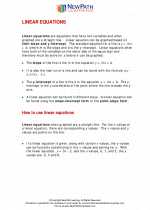
 Worksheet/Answer key
Worksheet/Answer key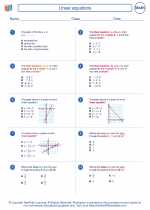
 Worksheet/Answer key
Worksheet/Answer key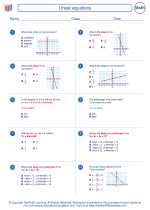
 Worksheet/Answer key
Worksheet/Answer key
 Worksheet/Answer key
Worksheet/Answer key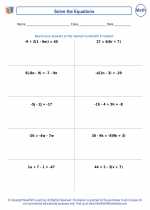
 Worksheet/Answer key
Worksheet/Answer key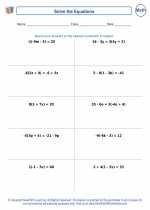
 Worksheet/Answer key
Worksheet/Answer key
